Fuel spill delays Columbia’s second launch
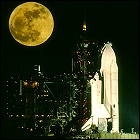 The second launch of Space Shuttle Columbia gets an unexpected one-month delay when a fuel leak forces NASA to remove, clean and re-attach 300 thermal tiles. The work can be done on-site, so Columbia simply stays on the pad. The second launch will be the last for the white external fuel tank, since NASA has determined that its brown insulating foam layer will cause no problems if left exposed; leaving off the coat of white paint saves several hundred pounds.
The second launch of Space Shuttle Columbia gets an unexpected one-month delay when a fuel leak forces NASA to remove, clean and re-attach 300 thermal tiles. The work can be done on-site, so Columbia simply stays on the pad. The second launch will be the last for the white external fuel tank, since NASA has determined that its brown insulating foam layer will cause no problems if left exposed; leaving off the coat of white paint saves several hundred pounds.
Columbia returns from orbit
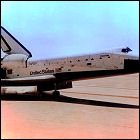 The first shuttle to return from space, Columbia touches down on the dry lake bed strip at Edwards Air Force Base in California, two days and six hours after liftoff (and after putting a cool million miles on the odometer). The aerodynamics involved in gliding after re-entry are found to be trickier than the previous test landings of the Enterprise. Inspection of the thermal tiles lining the shuttle’s belly reveals more damage than expected, and NASA begins working to refine the process of fitting the tiles to the shuttle.
The first shuttle to return from space, Columbia touches down on the dry lake bed strip at Edwards Air Force Base in California, two days and six hours after liftoff (and after putting a cool million miles on the odometer). The aerodynamics involved in gliding after re-entry are found to be trickier than the previous test landings of the Enterprise. Inspection of the thermal tiles lining the shuttle’s belly reveals more damage than expected, and NASA begins working to refine the process of fitting the tiles to the shuttle.
Columbia opens the doors
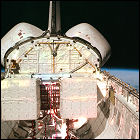 Safely in orbit, the cargo bay doors are opened for the first time on Space Shuttle Columbia, revealing that some of the shuttle’s protective thermal tiles are already missing. (A later post-landing inspection reveals that more than 100 tiles are damaged, and 16 tiles are completely lost, all probably due to unexpected vibration during launch.) NASA deems the damage non-critical and gives the go-ahead for a landing, even though it’s impossible to see what damage may have been done to the more critical tiles on the shuttle’s underbelly.
Safely in orbit, the cargo bay doors are opened for the first time on Space Shuttle Columbia, revealing that some of the shuttle’s protective thermal tiles are already missing. (A later post-landing inspection reveals that more than 100 tiles are damaged, and 16 tiles are completely lost, all probably due to unexpected vibration during launch.) NASA deems the damage non-critical and gives the go-ahead for a landing, even though it’s impossible to see what damage may have been done to the more critical tiles on the shuttle’s underbelly.
STS-1: Columbia’s first flight
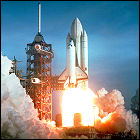 Space Shuttle Columbia lifts off on the shuttle system’s first flight into a space, with Commander John Young (a Gemini/Apollo veteran) and Robert Crippen aboard, the first two-man American crew since the Gemini program’s final flight in 1966. It’s a true test flight in every sense of the word – every previous American manned spacecraft had been flown unmanned first to verify safety and spaceworthiness, making the shuttle’s first flight a case where everything has to go perfectly the first time.
Space Shuttle Columbia lifts off on the shuttle system’s first flight into a space, with Commander John Young (a Gemini/Apollo veteran) and Robert Crippen aboard, the first two-man American crew since the Gemini program’s final flight in 1966. It’s a true test flight in every sense of the word – every previous American manned spacecraft had been flown unmanned first to verify safety and spaceworthiness, making the shuttle’s first flight a case where everything has to go perfectly the first time.
Columbia launch scrubbed
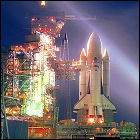 The first attempt to launch Space Shuttle Columbia on her maiden voyage is called off due to problems with the shuttle’s sophisticated system of redundant flight computers, some of which fail to synchronize with each other during the countdown. Over 24 hours are required to fix the bug, and the launch is delayed by two days.
The first attempt to launch Space Shuttle Columbia on her maiden voyage is called off due to problems with the shuttle’s sophisticated system of redundant flight computers, some of which fail to synchronize with each other during the countdown. Over 24 hours are required to fix the bug, and the launch is delayed by two days.
Columbia rolls out to the pad
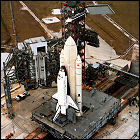 For the first time in the history of the delay-riddled Space Shuttle program, a complete, flight-ready vehicle is rolled out to the launch pad. Space Shuttle Columbia, atop the modified crawler vehicle which once carried Saturn V rockets to the pad, arrives at Cape Canaveral Launch Complex 39A, strapped to flight-qualified solid rocket boosters and a flight-ready external tank. (The shuttle Enterprise had been attached to empty boosters and tanks for fit checks as early as 1979.) Though preparation work continues to ready Columbia for flight, the shuttle is now in position for her first launch in 1981.
For the first time in the history of the delay-riddled Space Shuttle program, a complete, flight-ready vehicle is rolled out to the launch pad. Space Shuttle Columbia, atop the modified crawler vehicle which once carried Saturn V rockets to the pad, arrives at Cape Canaveral Launch Complex 39A, strapped to flight-qualified solid rocket boosters and a flight-ready external tank. (The shuttle Enterprise had been attached to empty boosters and tanks for fit checks as early as 1979.) Though preparation work continues to ready Columbia for flight, the shuttle is now in position for her first launch in 1981.
Columbia completed (almost)
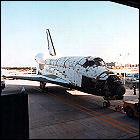 Space Shuttle Columbia is officially rolled out of the Rockwell International construction facility in Palmdale, California, even though her outer “skin” is still unfinished – NASA technicians continue working on perfecting the first spaceworthy shuttle’s thermal tiles for much of the next year, delaying the first launch until sometime in 1981 (just another in a series of delays for a vehicle that had been intended to fly as early as 1977).
Space Shuttle Columbia is officially rolled out of the Rockwell International construction facility in Palmdale, California, even though her outer “skin” is still unfinished – NASA technicians continue working on perfecting the first spaceworthy shuttle’s thermal tiles for much of the next year, delaying the first launch until sometime in 1981 (just another in a series of delays for a vehicle that had been intended to fly as early as 1977).
Christening the fleet
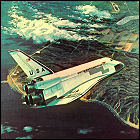 After several years of referring to the various Space Shuttle orbiters both under construction and in planning by numbers, NASA bestows names upon the anticipated fleet of four orbiters. OV-102, which is still expected to fly “late this year”, is named Columbia, while OV-099, undergoing conversion from a test article to flight-worthy vehicle, is named Challenger. Orbiters 103 and 104 will be named, respectively, Discovery and Atlantis; all four names are drawn from historical seafaring exploration vessels. (NASA has also used some of the names before: Columbia was the name of the moon-orbiting command module in the Apollo 11 mission, while Apollo 17’s lunar lander was named Challenger.)
After several years of referring to the various Space Shuttle orbiters both under construction and in planning by numbers, NASA bestows names upon the anticipated fleet of four orbiters. OV-102, which is still expected to fly “late this year”, is named Columbia, while OV-099, undergoing conversion from a test article to flight-worthy vehicle, is named Challenger. Orbiters 103 and 104 will be named, respectively, Discovery and Atlantis; all four names are drawn from historical seafaring exploration vessels. (NASA has also used some of the names before: Columbia was the name of the moon-orbiting command module in the Apollo 11 mission, while Apollo 17’s lunar lander was named Challenger.)
The Space Shuttle’s ambitious schedule
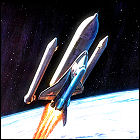 NASA prepares a preliminary schedule of Space Shuttle launches, covering the years 1979-1982 (and assuming the shuttle will be ready to launch in 1979). The ambitious schedule (which also assumes, in line with current planning, that the test orbiter Enterprise will be upgraded to spaceworthiness) includes almost-monthly flights from 1979 onward to deploy communications and weather satellites already on the drawing board, as well as frequent science missions with the cargo-bay-mounted Spacelab. On only the second test flight, the schedule has OV-102 (yet to be named Columbia) slated for a mission to the abandoned early 1970s space station Skylab, using a teleoperator retrieval system which also exists only on paper. While many of the schedule’s goals will be met, the delay in the shuttle program will be longer than NASA anticipates at this time.
NASA prepares a preliminary schedule of Space Shuttle launches, covering the years 1979-1982 (and assuming the shuttle will be ready to launch in 1979). The ambitious schedule (which also assumes, in line with current planning, that the test orbiter Enterprise will be upgraded to spaceworthiness) includes almost-monthly flights from 1979 onward to deploy communications and weather satellites already on the drawing board, as well as frequent science missions with the cargo-bay-mounted Spacelab. On only the second test flight, the schedule has OV-102 (yet to be named Columbia) slated for a mission to the abandoned early 1970s space station Skylab, using a teleoperator retrieval system which also exists only on paper. While many of the schedule’s goals will be met, the delay in the shuttle program will be longer than NASA anticipates at this time.
Columbia under construction
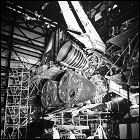 Construction begins on Space Shuttle Orbiter Vehicle 102 (OV-102 for short), the shuttle orbiter that NASA intends to launch as early as 1977. But OV-102 encounters the inherent pitfalls of being the first of its kind: years of delays are ahead, with many of the delays linked to the complicated system of protective thermal tiles designed to bear the brunt of the shuttle’s punishing re-entry through the atmosphere. (The test orbiter, later named Enterprise, is never intended for spaceflight, so it only has to conform to the shape and weight of a returning shuttle for landing tests, and therefore it doesn’t face the same hurdles.) OV-102’s first flight won’t take place until 1981, leaving a six-year gap between manned American spaceflights; during this period OV-102 will be named Columbia.
Construction begins on Space Shuttle Orbiter Vehicle 102 (OV-102 for short), the shuttle orbiter that NASA intends to launch as early as 1977. But OV-102 encounters the inherent pitfalls of being the first of its kind: years of delays are ahead, with many of the delays linked to the complicated system of protective thermal tiles designed to bear the brunt of the shuttle’s punishing re-entry through the atmosphere. (The test orbiter, later named Enterprise, is never intended for spaceflight, so it only has to conform to the shape and weight of a returning shuttle for landing tests, and therefore it doesn’t face the same hurdles.) OV-102’s first flight won’t take place until 1981, leaving a six-year gap between manned American spaceflights; during this period OV-102 will be named Columbia.